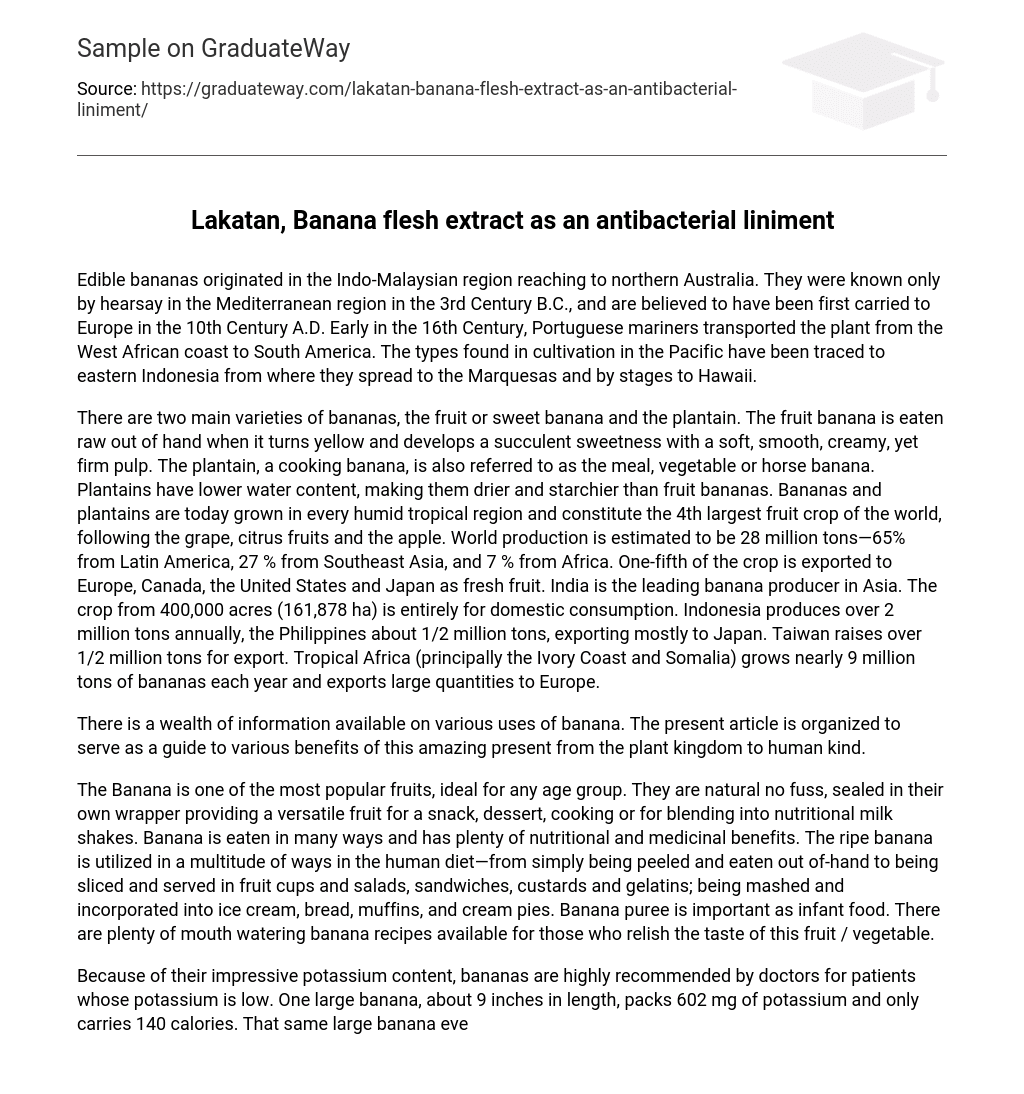Edible bananas originated in the Indo-Malaysian region reaching to northern Australia. They were known only by hearsay in the Mediterranean region in the 3rd Century B.C., and are believed to have been first carried to Europe in the 10th Century A.D. Early in the 16th Century, Portuguese mariners transported the plant from the West African coast to South America. The types found in cultivation in the Pacific have been traced to eastern Indonesia from where they spread to the Marquesas and by stages to Hawaii.
There are two main varieties of bananas, the fruit or sweet banana and the plantain. The fruit banana is eaten raw out of hand when it turns yellow and develops a succulent sweetness with a soft, smooth, creamy, yet firm pulp. The plantain, a cooking banana, is also referred to as the meal, vegetable or horse banana. Plantains have lower water content, making them drier and starchier than fruit bananas. Bananas and plantains are today grown in every humid tropical region and constitute the 4th largest fruit crop of the world, following the grape, citrus fruits and the apple. World production is estimated to be 28 million tons—65% from Latin America, 27 % from Southeast Asia, and 7 % from Africa. One-fifth of the crop is exported to Europe, Canada, the United States and Japan as fresh fruit. India is the leading banana producer in Asia. The crop from 400,000 acres (161,878 ha) is entirely for domestic consumption. Indonesia produces over 2 million tons annually, the Philippines about 1/2 million tons, exporting mostly to Japan. Taiwan raises over 1/2 million tons for export. Tropical Africa (principally the Ivory Coast and Somalia) grows nearly 9 million tons of bananas each year and exports large quantities to Europe.
There is a wealth of information available on various uses of banana. The present article is organized to serve as a guide to various benefits of this amazing present from the plant kingdom to human kind.
The Banana is one of the most popular fruits, ideal for any age group. They are natural no fuss, sealed in their own wrapper providing a versatile fruit for a snack, dessert, cooking or for blending into nutritional milk shakes. Banana is eaten in many ways and has plenty of nutritional and medicinal benefits. The ripe banana is utilized in a multitude of ways in the human diet—from simply being peeled and eaten out of-hand to being sliced and served in fruit cups and salads, sandwiches, custards and gelatins; being mashed and incorporated into ice cream, bread, muffins, and cream pies. Banana puree is important as infant food. There are plenty of mouth watering banana recipes available for those who relish the taste of this fruit / vegetable.
Because of their impressive potassium content, bananas are highly recommended by doctors for patients whose potassium is low. One large banana, about 9 inches in length, packs 602 mg of potassium and only carries 140 calories. That same large banana even has 2 grams of protein and 4 grams of fiber. No wonder the banana was considered an important food to boost the health of malnourished children
Those reducing sodium in their diets can’t go wrong with a banana with its mere 2 mgs of sodium. For the carbohydrate counters there are 36 grams of carbohydrates in a large banana.
The other banana nutrition facts are also quite impressive. Vitamins and minerals are abundant in the banana, offering 123 I.U. of vitamin A for the large size. Banana also has a full range of B vitamins with .07 mg of Thiamine, .15 mg of Riboflavin, .82 mg Niacin, .88 mg vitamin B6, and 29 mcg of Folic Acid. There is even 13.8 mg of vitamin C. On the mineral scale Calcium counts in at 9.2 mg, Magnesium 44.1 mg, with trace amounts of iron and zinc.
Putting all of the nutritional figures together clearly shows the banana is among the healthiest of fruits. The plantain, when cooked, rates slightly higher on the nutritional scale in vitamins and minerals but similar to the banana in protein and fiber content.





